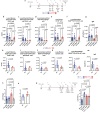Sensory neurons regulate stimulus-dependent humoral immunity in mouse models of bacterial infection and asthma
- PMID: 39414787
- PMCID: PMC11484968
- DOI: 10.1038/s41467-024-53269-3
Sensory neurons regulate stimulus-dependent humoral immunity in mouse models of bacterial infection and asthma
Abstract
Sensory neurons sense pathogenic infiltration to drive innate immune responses, but their role in humoral immunity is unclear. Here, using mouse models of Streptococcus pneumoniae infection and Alternaria alternata asthma, we show that sensory neurons are required for B cell recruitment and antibody production. In response to S. pneumoniae, sensory neuron depletion increases bacterial burden and reduces B cell numbers, IgG release, and neutrophil stimulation. Meanwhile, during A. alternata-induced airway inflammation, sensory neuron depletion decreases B cell population sizes, IgE levels, and asthmatic characteristics. Mechanistically, during bacterial infection, sensory neurons preferentially release vasoactive intestinal polypeptide (VIP). In response to asthma, sensory neurons release substance P. Administration of VIP into sensory neuron-depleted mice suppresses bacterial burden, while VIPR1 deficiency increases infection. Similarly, exogenous substance P delivery aggravates asthma in sensory neuron-depleted mice, while substance P deficiency ameliorates asthma. Our data, thus demonstrate that sensory neurons release select neuropeptides which target B cells dependent on the immunogen.
© 2024. The Author(s).
Conflict of interest statement
D.A., M.S., and N.J. declare the following competing interests. U.S. Patent Application Serial Number 63/492,846. Methods of using sensory neuron neurotransmitters to enhance humoral immunity. The remaining authors do not declare competing interests.
Figures









Update of
-
Sensory neurons regulate stimulus-dependent humoral immunity.bioRxiv [Preprint]. 2024 Aug 13:2024.01.04.574231. doi: 10.1101/2024.01.04.574231. bioRxiv. 2024. Update in: Nat Commun. 2024 Oct 16;15(1):8914. doi: 10.1038/s41467-024-53269-3. PMID: 38260709 Free PMC article. Updated. Preprint.
References
Publication types
MeSH terms
Substances
Grants and funding
- UL1TR001881-01/U.S. Department of Health & Human Services | NIH | National Center for Advancing Translational Sciences (NCATS)
- AI171795/U.S. Department of Health & Human Services | NIH | National Institute of Allergy and Infectious Diseases (NIAID)
- R01 AI169687/AI/NIAID NIH HHS/United States
- EDUC4-12837/California Institute for Regenerative Medicine (CIRM)
- T32KT4708/Tobacco-Related Disease Research Program (TRDRP)
- K24 AI171795/AI/NIAID NIH HHS/United States
- R56 AI175328/AI/NIAID NIH HHS/United States
- R21 AI159221/AI/NIAID NIH HHS/United States
- I01 BX005073/BX/BLRD VA/United States
- BLR&D BX005073/Department of Veterans Affairs | Veterans Affairs San Diego Healthcare System (VA San Diego Healthcare System)
- UL1 TR001881/TR/NCATS NIH HHS/United States
- R56AI175328/U.S. Department of Health & Human Services | NIH | National Institute of Allergy and Infectious Diseases (NIAID)
- R21AI159221/U.S. Department of Health & Human Services | NIH | National Institute of Allergy and Infectious Diseases (NIAID)
LinkOut - more resources
Full Text Sources
Other Literature Sources
Medical
Molecular Biology Databases

